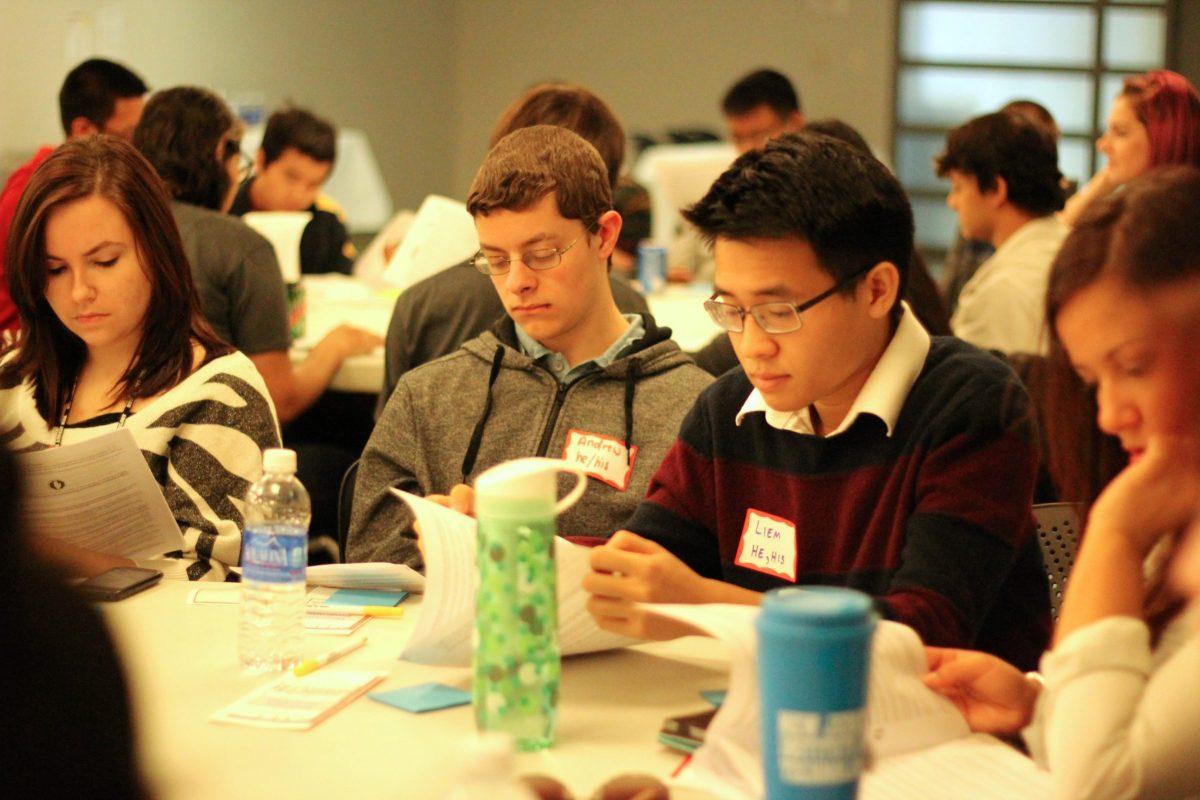Friday November 11th– The Lavender Leaders from the LGBTQ center of Montclair State University came to NJIT to host an interactive workshop for students on behalf of the Division of Academic Support and Student Affairs. This workshop gave NJIT students the opportunity to better understand and learn more about people who identified as lesbian, gay, bisexual, transgender, and queer in everyday life through a series of interactive activities.
At the workshop, students wore a labeled name tag with their name and their preferred pronouns. All attendees sat in a small group with one of the Lavender leaders. Each member of the group introduced themselves to the other members at the table and mentioned their preferred pronouns. The workshop explained what the different kinds of pronouns were and the significance of each pronoun.
The most common pronouns are gender binary; he/his/him refers to males, she/her/hers refers to females. There are other pronouns such as ze/zir and per, which are more gender neutral. Other people prefer not to be addressed with pronouns and just by their first name. It is important to call people by their preferred pronouns as it is their personal form of gender identification.
In the next activity, participants were given three minutes to honestly write down the first words that entered their minds after thinking about the LGBTQ community onto post-it notes. Derogatory and fowl slang words were permitted. The post-it notes were all in the same color to preserve anonymity. After, participants were to post their post-it notes onto a wall, with the left side of the wall having negative words, and the right side of the wall having positive words. From this exercise, people were able to see and better understand both an insider’s and outsider’s view of the gay community. Many of the words posted on the left (negative) side were also posted on the right (positive) side—this shows that terminology can also be interpreted differently. Regardless, this eye-opening activity showed genuine opinions and perception of the LGBTQ community, both from those who identify as LGBTQ or as heterosexual.
The following activity had participants to analyze and think about their own biological sex, gender, and sexuality. Each of these three components to a human being are different and are on a spectrum. The lavender leaders explained where they were on each of the three spectrums, then had participants think about themselves and place where they thought they were on each spectrum. Information was anonymous and participants did not need to share where they thought they were unless they wanted to.
Given that some of the participants did not identify as LGBTQ, the final activity at the workshop had all participants pretend they were gay, lesbian, bi, transgendered, or queer. All of the participants in the room were handed a star of a certain color—yellow, blue, orange, or purple. On each point of the star, participants were to write one of the following five aspects of their personal lives: their best friend, closest family member, a community they belonged to, their current job or role in society, and their dreams and aspirations. Afterwards, all participants in the room gathered around in a large circle and each participant in the circle was instructed to rip off or fold over specific parts of their personal lives, based off of the color of their star. This simulated different people in their lives not initially or never being accepting of the participant’s sexuality. Those given blue stars ended up not having to rip or fold any part of their star, and those given yellow stars ripped off all five parts of their personal lives. Orange and purple star holders ripped and creased some parts of their lives except for their personal dreams.
This activity was extremely representative of the types of lives of different LGBTQ people. There are some whose lives are unaffected by their sexuality (as represented by blue stars), while there are others who suffer their entire lives due to isolation and a lack of support (as represented by yellow stars). Other people lose some people in their lives, but find support in others (as represented by purple and orange stars). A majority of participants received yellow stars, and this represents the statistic of 40% of LGBTQ youth lacking the support they need, resulting in homelessness, drug and substance abuse, or both. Blue stars were given to very few members of the circle because most LGBTQ people lead lives where their sexuality unfortunately changes or ruins relationships. This rather poetic activity allowed all of the participants, gay or straight, to recognize and better understand the need for love and support to succeed in life.
At NJIT, there are several outlets for LGBTQ students on campus to find a community or safe space to feel safe enough to openly express themselves, many of which include Spectrum, the Out and About Group, CCAPs, and the Diversity Center. The Lavender Leaders of Montclair State University, Spectrum, and the Diversity Center will be hosting future workshops to give students the chance to learn more about the lives of those who identify as LGBTQ, as well as opportunities for students to meet new people and find support. If a student ever feels isolated, alone, and in need of support, they should reach out to these resources because there are others on campus who feel the same way and can truly understand and relate—everyone deserves love and support for who they are, regardless of difference in race, gender, sex, religion, skin color, or sexual orientation.

































